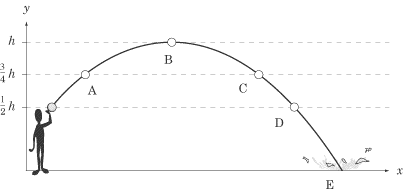英华教育(青岛)语言中心--SAT物理:Forms of Energy-英华外语整理SAT物理:Forms of Energy,供学员学习。班制灵活,随报随学,英华教育咨询热线:400-0532-757
Though energy is always measured in joules, and though it can always be defined as a capacity to do work, energy manifests itself in a variety of different forms. These various forms pop up all over SAT II Physics, and we will look at some additional forms of energy when we discuss electromagnetism, relativity, and a number of other specialized topics. For now, we will focus on the kinds of energy you’ll find in mechanics problems. Kinetic Energy Kinetic energy is the energy a body in motion has by virtue of its motion. We define energy as the capacity to do work, and a body in motion is able to use its motion to do work. For instance, a cue ball on a pool table can use its motion to do work on the eight ball. When the cue ball strikes the eight ball, the cue ball comes to a stop and the eight ball starts moving. This occurs because the cue ball’s kinetic energy has been transferred to the eight ball. There are many types of kinetic energy, including vibrational, translational, and rotational. Translational kinetic energy, the main type, is the energy of a particle moving in space and is defined in terms of the particle’s mass, m, and velocity, v:
For instance, a cue ball of mass 0.5 kg moving at a velocity of 2 m/s has a kinetic energy of 1/2 (0.5 kg)(2 m/s)2 = 1 J. The Work-Energy Theorem If you recall, work is a measure of the transfer of energy. An object that has a certain amount of work done on it has that amount of energy transferred to it. This energy moves the object over a certain distance with a certain force; in other words, it is kinetic energy. This handy little fact is expressed in the work-energy theorem, which states that the net work done on an object is equal to the object’s change in kinetic energy:
For example, say you apply a force to a particle, causing it to accelerate. This force does positive work on the particle and increases its kinetic energy. Conversely, say you apply a force to decelerate a particle. This force does negative work on the particle and decreases its kinetic energy. If you know the forces acting on an object, the work-energy theorem provides a convenient way to calculate the velocity of a particle. Example
A hockey puck of mass 1 kg slides across the ice with an initial velocity of 10 m/s. There is a 1 N force of friction acting against the puck. What is the puck’s velocity after it has glided 32 m along the ice?
If we know the puck’s kinetic energy after it has glided 32 m, we can calculate its velocity. To determine its kinetic energy at that point, we need to know its initial kinetic energy, and how much that kinetic energy changes as the puck glides across the ice. First, let’s determine the initial kinetic energy of the puck. We know the puck’s initial mass and initial velocity, so we just need to plug these numbers into the equation for kinetic energy:
The friction between the puck and the ice decelerates the puck. The amount of work the ice does on the puck, which is the product of the force of friction and the puck’s displacement, is negative.
The work done on the puck decreases its kinetic energy, so after it has glided 32 m, the kinetic energy of the puck is 50 – 32 = 18 J. Now that we know the final kinetic energy of the puck, we can calculate its final velocity by once more plugging numbers into the formula for kinetic energy:

We could also have solved this problem using Newton’s Second Law and some kinematics, but the work-energy theorem gives us a quicker route to the same answer. Potential Energy As we said before, work is the process of energy transfer. In the example above, the kinetic energy of the puck was transferred into the heat and sound caused by friction. There are a great number of objects, though, that spend most of their time neither doing work nor having work done on them. This book in your hand, for instance, is not doing any work right now, but the second you drop it—whoops!—the force of gravity does some work on it, generating kinetic energy. Now pick up the book and let’s continue. Potential energy, U, is a measure of an object’s unrealized potential to have work done on it, and is associated with that object’s position in space, or its configuration in relation to other objects. Any work done on an object converts its potential energy into kinetic energy, so the net work done on a given object is equal to the negative change in its potential energy:
Be very respectful of the minus sign in this equation. It may be tempting to think that the work done on an object increases its potential energy, but the opposite is true. Work converts potential energy into other forms of energy, usually kinetic energy. Remove the minus sign from the equation above, and you are in direct violation of the law of conservation of energy! There are many forms of potential energy, each of which is associated with a different type of force. SAT II Physics usually confines itself to gravitational potential energy and the potential energy of a compressed spring. We will review gravitational potential energy in this section, and the potential energy of a spring in the next chapter. Gravitational Potential Energy Gravitational potential energy registers the potential for work done on an object by the force of gravity. For example, say that you lift a water balloon to height h above the ground. The work done by the force of gravity as you lift the water balloon is the force of gravity, –mg, times the water balloon’s displacement, h. So the work done by the force of gravity is W = –mgh. Note that there is a negative amount of work done, since the water balloon is being lifted upward, in the opposite direction of the force of gravity. By doing –mgh joules of work on the water balloon, you have increased its gravitational potential energy by mgh joules (recall the equation ). In other words, you have increased its potential to accelerate downward and cause a huge splash. Because the force of gravity has the potential to do mgh joules of work on the water balloon at height h, we say that the water balloon has mgh joules of gravitational potential energy.
For instance, a 50 kg mass held at a height of 4 m from the ground has a gravitational potential energy of:
The most important thing to remember is that the higher an object is off the ground, the greater its gravitational potential energy. Mechanical EnergyWe now have equations relating work to both kinetic and potential energy:

Combining these two equations gives us this important result:
Or, alternatively,
As the kinetic energy of a system increases, its potential energy decreases by the same amount, and vice versa. As a result, the sum of the kinetic energy and the potential energy in a system is constant. We define this constant as E, the mechanical energy of the system:
This law, the conservation of mechanical energy, is one form of the more general law of conservation of energy, and it’s a handy tool for solving problems regarding projectiles, pulleys, springs, and inclined planes. However, mechanical energy is not conserved in problems involving frictional forces. When friction is involved, a good deal of the energy in the system is dissipated as heat and sound. The conservation of mechanical energy only applies to closed systems. Example 1
A student drops an object of mass 10 kg from a height of 5 m. What is the velocity of the object when it hits the ground? Assume, for the purpose of this question, that g = –10 m/s2.
Before the object is released, it has a certain amount of gravitational potential energy, but no kinetic energy. When it hits the ground, it has no gravitational potential energy, since h = 0, but it has a certain amount of kinetic energy. The mechanical energy, E, of the object remains constant, however. That means that the potential energy of the object before it is released is equal to the kinetic energy of the object when it hits the ground. When the object is dropped, it has a gravitational potential energy of:
By the time it hits the ground, all this potential energy will have been converted to kinetic energy. Now we just need to solve for v:

Example 2

Consider the above diagram of the trajectory of a thrown tomato:
1. At what point is the potential energy greatest?
2. At what point is the kinetic energy the least?
3. At what point is the kinetic energy greatest?
4. At what point is the kinetic energy decreasing and the potential energy increasing?
5. At what point are the kinetic energy and the potential energy equal to the values at position A?
The answer to question 1 is point B. At the top of the tomato’s trajectory, the tomato is the greatest distance above the ground and hence has the greatest potential energy. The answer to question 2 is point B. At the top of the tomato’s trajectory, the tomato has the smallest velocity, since the y-component of the velocity is zero, and hence the least kinetic energy. Additionally, since mechanical energy is conserved in projectile motion, we know that the point where the potential energy is the greatest corresponds to the point where the kinetic energy is smallest. The answer to question 3 is point E. At the bottom of its trajectory, the tomato has the greatest velocity and thus the greatest kinetic energy. The answer to question 4 is point A. At this point, the velocity is decreasing in magnitude and the tomato is getting higher in the air. Thus, the kinetic energy is decreasing and the potential energy is increasing. The answer to question 5 is point C. From our study of kinematics, we know that the speed of a projectile is equal at the same height in the projectile’s ascent and descent. Therefore, the tomato has the same kinetic energy at points A and C. Additionally, since the tomato has the same height at these points, its potential energy is the same at points A and C. Keep this example in mind when you take SAT II Physics, because it is likely that a similar question will appear on the test. Thermal Energy There are many cases where the energy in a system seems simply to have disappeared. Usually, this is because that energy has been turned into sound and heat. For instance, a coin sliding across a table slows down and comes to a halt, but in doing so, it produces the sound energy of the coin scraping along the table and the heat energy of friction. Rub your hands together briskly and you will feel that friction causes heat. We will discuss thermal energy, or heat, in greater detail in Chapter 9, but it’s worth noting here that it is the most common form of energy produced in energy transformations. It’s hard to think of an energy transformation where no heat is produced. Take these examples:Friction acts everywhere, and friction produces heat. Electric energy produces heat: a light bulb produces far more heat than it does light. When people talk about burning calories, they mean it quite literally: exercise is a way of converting food energy into heat. Sounds fade to silence because the sound energy is gradually converted into the heat of the vibrating air molecules. In other words, if you shout very loudly, you make the air around you warmer!
















 (高老师)
(高老师)


